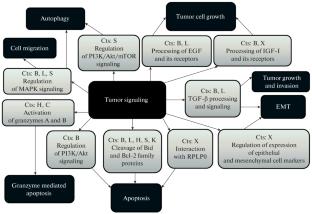Cysteine Cathepsins: Structure, Physiological Functions, and the Role in Carcinogenesis
Abstract—
Cysteine cathepsins (Cts) also known as thiol proteinases belong to the superfamily of cysteine proteinases. Most Cts are endopeptidases; some of them exhibit exopeptidase activity. All Cts are synthesized as zymogens and activation of most of them occurs autocatalytically. Ct activity depends on pH and it is regulated by endogenous inhibitors. Although the major role of Cts consists in lysosomal degradation of cell proteins these enzymes are also detected in the nucleus, cytoplasm, plasma membrane, and in the extracellular medium. The latter is especially important in the case of certain pathological including cancer. Extracellular Cts not only hydrolyze extracellular matrix (ECM) proteins, but also contribute to ECM remodeling via specific processing of various proteins including cytokines, chemokines, cell adhesion molecules. Normally, expression and activity of Cts are very low and these enzymes are mainly detected inside cells. In cancer, the expression and activity of Cts sharply increase both in cell lysosomes and in the intercellular space and this promotes neoplastic transformation, invasion, metastasis and leads to further tumor progression. It has been shown that Cts expression depends on the cells type, and therefore, their role in the tumor development differs in dependence of their cellular origin. However, the mechanism of Cts action is not limited only by their proteolytic degradation of ECM proteins. Cts play an important role in processing of proteins involved in oncogenic cell signaling. For example, Cts participation in processing of growth factors is mediated through receptor tyrosine kinases (RTK) and various signaling mitogen-activated protein kinases (MAPK), which are involved in regulation of such cell processes as gene transcription, apoptosis, proliferation, and cell migration capacity. In addition, Cts also promote the epithelial-mesenchymal transition (EMT) by activating TGF-β signaling, which is considered as one of the key signaling pathways in this process.


 求助内容:
求助内容: 应助结果提醒方式:
应助结果提醒方式:


